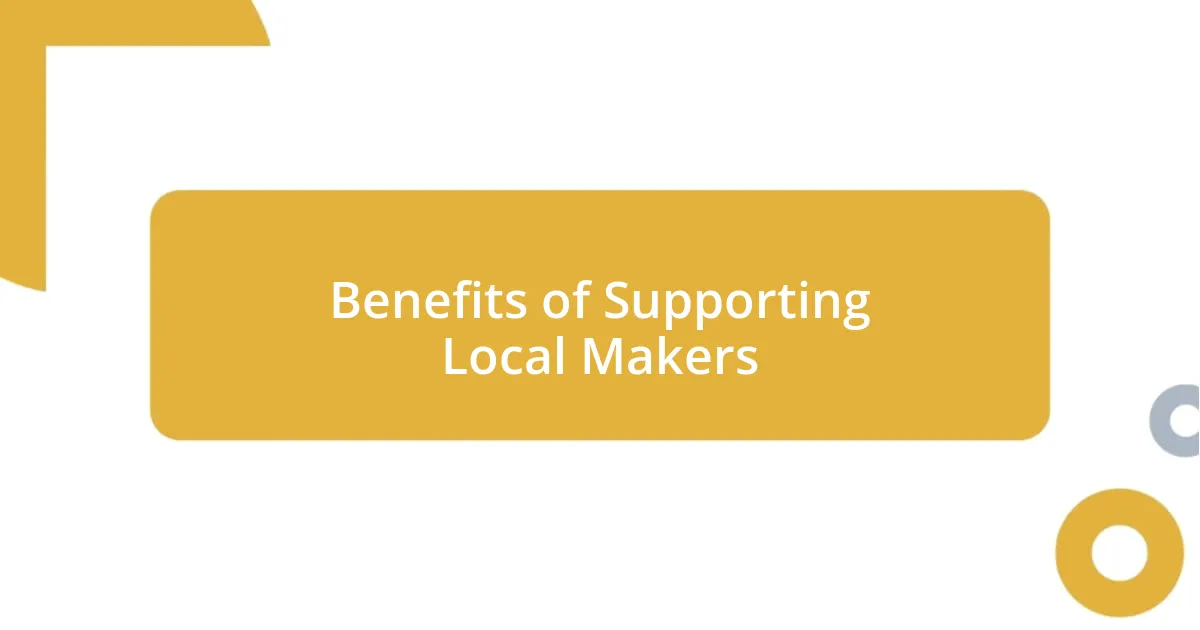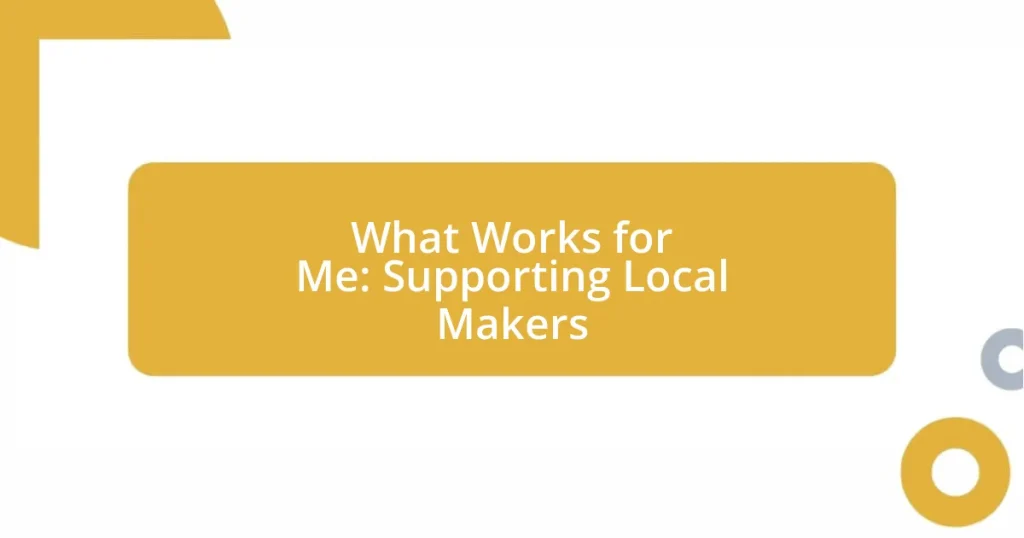Key takeaways:
- The local makers movement emphasizes the value of handmade goods, fostering creativity, community, and sustainability.
- Supporting local artisans enhances economic growth, preserves cultural diversity, and builds strong community ties.
- Engaging with local makers offers opportunities for personal connections and authentic learning experiences.
- Success stories highlight the transformative impact of community support on local makers, leading to thriving small businesses and sustainable practices.

Understanding Local Makers Movement
The local makers movement is a vibrant community that champions creativity, craftsmanship, and sustainability. I remember attending a local maker fair where I was struck by the passion of artisans showcasing their homemade goods. Each booth told a story, inviting me to ask questions and learn about the processes behind their creations. Doesn’t it feel rewarding to connect with someone who genuinely cares about their craft?
At its core, this movement emphasizes the value of handmade over mass-produced items. I once bought a handcrafted ceramic mug from a local maker, and it instantly became my favorite for morning coffee. Every sip reminds me of the artist’s hard work and dedication. Isn’t it amazing how a simple object can carry so much meaning and emotion?
Supporting local makers not only nurtures individual talents but also strengthens our communities. I often find myself reflecting on how purchasing from local artisans helps create jobs and fosters economic growth. Have you ever thought about the ripple effect that comes from choosing to buy local? It’s about more than just a transaction; it’s an investment in creativity and connection.

Importance of Supporting Local Makers
Supporting local makers holds immense importance for numerous reasons beyond the immediate exchange of goods. I still remember the feeling of delight when I unwrapped a hand-knit scarf made by a neighbor. It was not just a warm accessory but a tangible reminder of our community’s talent and spirit. Each stitch was imbued with care, making me cherish it even more. Isn’t it interesting how these personal connections can make our purchases so much more meaningful?
When we invest in local artisans, we are also fostering unique creativity and cultural diversity. I’ve visited numerous workshops where I saw local makers honing their skills and crafting their identities. It struck me how essential these artisans are in preserving traditions while also innovating. This blend of old and new enriches our local culture in ways that mass production simply cannot replicate. Have you ever wondered how many stories a local maker’s work can tell compared to something pulled off a retail shelf?
On a practical level, supporting local makers strengthens our economy and builds community ties. I’ve noticed a shift in our neighborhood since more people started prioritizing local purchases. Small businesses typically reinvest their profits back into the community, leading to vibrant local economies. Isn’t it rewarding to know that your spending choices can contribute to a thriving local scene? Investing in our local makers is not just about consumption, but about enhancing our shared environment and quality of life.
| Aspect | Local Makers |
|---|---|
| Connection to Community | Strong |
| Creativity & Culture | Diverse and Unique |
| Economic Impact | Reinvest in Local |

How to Identify Local Makers
Identifying local makers can be a rewarding journey filled with discovery and connection. One of the easiest ways I’ve found is to explore local markets or fairs. It’s incredible how just by strolling through a craft fair, I can spot makers who take pride in their unique creations. Each interaction is an opportunity to learn directly from them about their inspiration and techniques.
Here are some practical tips to help you identify local makers:
- Visit Farmers’ Markets: Often, local artisans showcase their handmade items alongside fresh produce.
- Explore Craft Fairs and Art Shows: These events are filled with talented individuals eager to share their craft.
- Check Online Platforms: Websites and social media groups dedicated to local artisans can lead you to hidden gems.
- Engage with Your Community: Attend local workshops or classes where makers share their skills and stories.
- Look for Local Shops: Many stores specialize in selling handcrafted items from nearby artisans.
While browsing my local pop-up events, I remember discovering a woodworker whose passion for his craft was evident. Every piece he showcased had a story, and I felt a genuine connection to the heart and soul of his work. It’s these moments that truly bring the local maker community to life!

Engaging with Local Maker Communities
Engaging with local maker communities is an experience that goes beyond mere transactions. The first time I attended a maker meet-up, I found myself surrounded by passionate individuals who were eager to share their crafts. Each conversation was a window into someone’s world—whether it was a potter discussing their glazing techniques or a candle maker revealing the secrets behind their unique scents. Isn’t it fascinating how these gatherings can spark new friendships and inspire collaboration?
What truly resonates with me is the sense of belonging that comes from engaging with local artisans. I recall one memorable evening where we set up a community art swap, allowing makers to exchange their creations. The air buzzed with excitement as we traded stories and ideas, each person illuminating their own journey. That night, I realized that these connections are not just about supporting local talent; they are about creating a network enriched with shared experiences and mutual encouragement.
As I look back at various workshops I’ve attended, the joy of learning directly from makers has been remarkable. I once tried my hand at pottery, where the instructor patiently guided me through each step. The satisfaction of shaping a bowl with my own hands, knowing it would be part of the local artisan legacy, was undeniable. How often do we get the chance to engage authentically with our community like that? By immersing ourselves in these spaces, we not only support makers but also discover the beauty of our local fabric.

Benefits of Supporting Local Makers
Supporting local makers offers a multitude of benefits that resonate deeply with me. For one, purchasing handmade items fosters a unique connection between the creator and the consumer. I still remember the joy of buying a hand-knitted scarf from a local artisan; it wasn’t just a purchase, but a heartfelt exchange. When you hold something made with love and care, it feels special—like you’re wrapping yourself in a story.
Moreover, supporting local makers injects vitality into our communities. Each purchase helps sustain these creators, allowing them to continue their craft and share their talents. I’ve often walked into a local shop and felt a genuine excitement seeing familiar faces, knowing that my support helps keep their passion alive. It’s like being part of a larger family—one that celebrates creativity, diversity, and the richness of local culture.
Finally, there’s an undeniable environmental impact to consider. Local makers tend to use sustainable materials and practices, reducing the carbon footprint associated with large-scale production and shipping. A couple of months ago, I bought a beautifully crafted wooden toy for my niece, and the joy it brought her was coupled with peace of mind knowing it was made from reclaimed wood. Isn’t it empowering to make choices that benefit not just our communities but the planet as well? Supporting local makers is a win-win that enhances our lives in so many ways.

Success Stories of Local Makers
One success story that truly moved me was with a local baker who turned her passion into a thriving business. At a community fair, I tasted her handmade pastries and instantly understood the dedication behind her craft. What struck me was how she not only baked with love but also involved her family in the process, creating a sense of tradition that resonated with everyone who sampled her treats. Isn’t it inspiring to see a small dream blossom, fueled by family support?
Another remarkable example is a young jeweler who started selling her pieces at a local farmers’ market. I remember meeting her and learning that she uses recycled materials in her designs. What made her journey even more compelling was her initial struggle; she shared how the local community rallied around her, helping her fund a workshop to expand her skills. It feels incredible to witness someone transform a challenge into an opportunity, don’t you think?
Lastly, I can’t help but reflect on the story of a woodworker who crafts furniture from reclaimed wood. He opened his shop with just a few tools and a dream. After sharing his story at a local event, people flocked to his business, excited to support a maker who cares about sustainability. I still remember the pride on his face when he showed me a table he’d built for a customer; it wasn’t just furniture—it was a piece of art with a story behind it. It’s moments like these that remind us why supporting local makers is so impactful.















